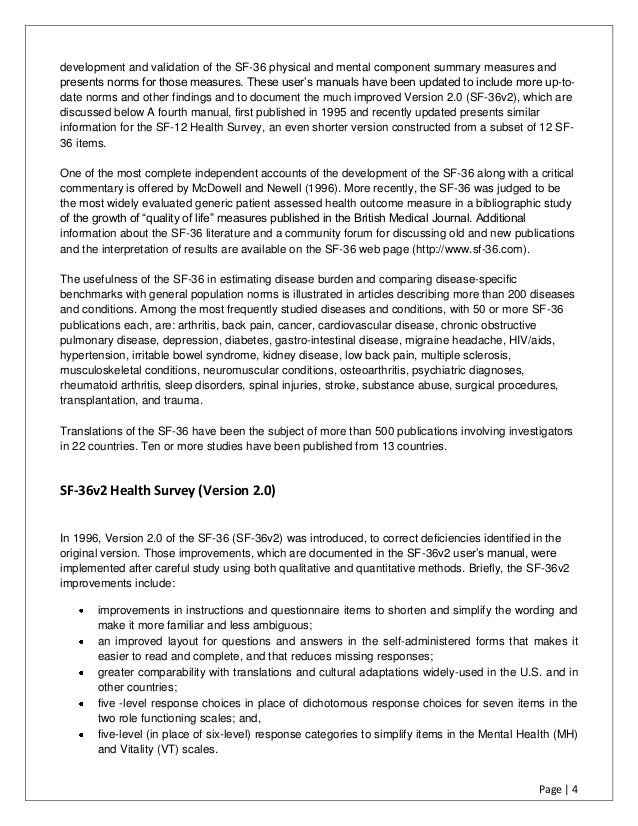And for the reported health transition item included in the SF-36 Health Survey. Chapter 3 describes the SF-36 scales and items. General scoring information and steps for data entry and scoring that are common to all items are discussed first (see Figure 6.1). Next, formulas for item aggregation and transformation of scale scores are presented. The average results in a survey of 25 patients amounted to 11.12 points; according to the results of this questionnaire, oral health did not play an insignificant role for any patient. Mar 01, 2013 SF-12v2 is a shortened form (12 items) of the SF-36v2 Health Survey. This is a generic assessment of health-related quality of life (HR QOL) from the client/patient’s perspective. Survey is administered as a questionnaire and can be self-administered.

User S Manual For The Sf-36v2 Health Survey

Sf 36v2 Health Survey
Maruish ME (2011) User’s manual for the SF-36v2 Health Survey (3rd ed.). Lincoln, RI: QualityMetric Incorporated. - TITLE: Psychometrics of the Short Form 36 Health Survey Version 2 (SF-36v2) and the Quality of Life Scale for Drug Addicts (QOL-DAv2.0) in Chinese Mainland Patients with Methadone Maintenance Treatment
- AUTHORS: Kaina Zhou, Guihua Zhuang, Hongmei Zhang, Peifeng Liang, Juan Yin, Lingling Kou, Mengmeng Hao, Lijuan You
- JOURNAL NAME: PLOS ONEDOI: 10.1371/journal.pone.0079828Sep 09, 2014
- ABSTRACT: Objective To test psychometrics of the Short Form 36 Health Survey version 2 (SF-36v2) and the Quality of Life Scale for Drug Addicts (QOL-DAv2.0) in Chinese mainland patients with methadone maintenance treatment (MMT). Methods A total of 1,212 patients were recruited from two MMT clinics in Xi’an, China. Reliability was estimated with Cronbach’s α and intra-class correlation (ICC). Convergent and discriminant validity was assessed using multitrait-multimethod correlation matrix. Sensitivity was measured with ANOVA and relative efficiency. Responsiveness was evaluated by pre-post paired-samples t-test and standardized response mean based on the patients’ health status changes following 6-month period. Results Cronbach’s α of the SF-36v2 physical and mental summary components were 0.80 and 0.86 (eight scales range 0.73–0.92) and the QOL-DAv2.0 was 0.96 (four scales range: 0.80–0.93). ICC of the SF-36v2 two components were 0.86 and 0.85 (eight scales range: 0.72–0.87) and the QOL-DAv2.0 was 0.94 (four scales range: 0.88–0.92). Convergent validity was lower between the two instruments (γ <0.70) while discriminant validity was acceptable within each instrument. Sensitivity was satisfied in self-evaluated health status (both instruments) and average daily methadone dose (SF-36v2 physical functioning and vitality scales; QOL-DAv2.0 except psychology scale). Responsiveness was acceptable in the improved health status change (SF-36v2 except vitality scale; QOL-DAv2.0 except psychology and symptoms scales) and deteriorated health status change (SF-36v2 except vitality, social functioning and mental health scales; QOL-DAv2.0 except society scale). Conclusions The SF-36v2 and the QOL-DAv2.0 are valid tools and can be used independently or complementary according to different emphases of health-related quality of life evaluation in patients with MMT.
|
